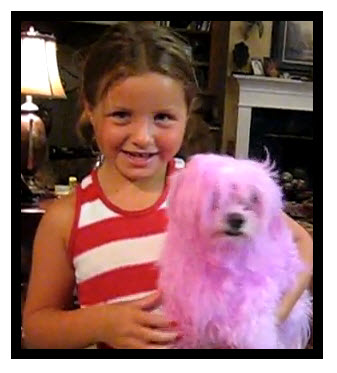Have you ever seen a dog with pink hair?
I have!
FYI: The Maltese dog shown had white hair before my granddaughter dyed its hair pink.

The genetics of hair color is very complex. In the most simplistic sense, hair color from black to white depends on a pigment called eumelanin.
The amount and type of eumelanin determines hair color. The less eumelanin the lighter the hair. The types of eumelanin are:
Brown eumelanin: blond to dark brown
Black eumelanin: grey to black
Let’s Play and Find Out About Hair Color
Using white, dark brown, and black paints, kids can mix the different paints to produce different shades of color.
The white paint acts as neutral, this would be hair without any color pigment. Adding different amounts of pigment to the white paint allows kids to produce different shades of brown and/or black.
1. First mix only white and black paint. I suggest placing small dabs of paint on a white paper plate. The plate can act as their color palette. Using toothpicks, kids can mix small amounts of the two colors.
Point out that only shades of black are produced.
2. Repeat step 1 using brown and white paint. You need only add a dab of brown paint to each child’s color palette (the white paper plate).
Point out that only shades of brown are produced.
3. Of course the kids can experiment with all three of the colors.
What about Red Hair?
Red hair is special. For hair to have any hint of red, the red pigment called pheomelanin must be present.
4. Add a dab of red paint to the palettes and Let the Fun Begin!
The book is designed to help young students catch the “science bug”
Teaching the Fun of Science to Young Learners
The book’s 75 lessons and reproducible activities touch on all areas of science and provide the key to a world of science magic and mystery. While kids will have fun doing the activities and learning to love science, they are also being encouraged to develop other skills, including reading, writing, math, and art.
(Paid Link)
